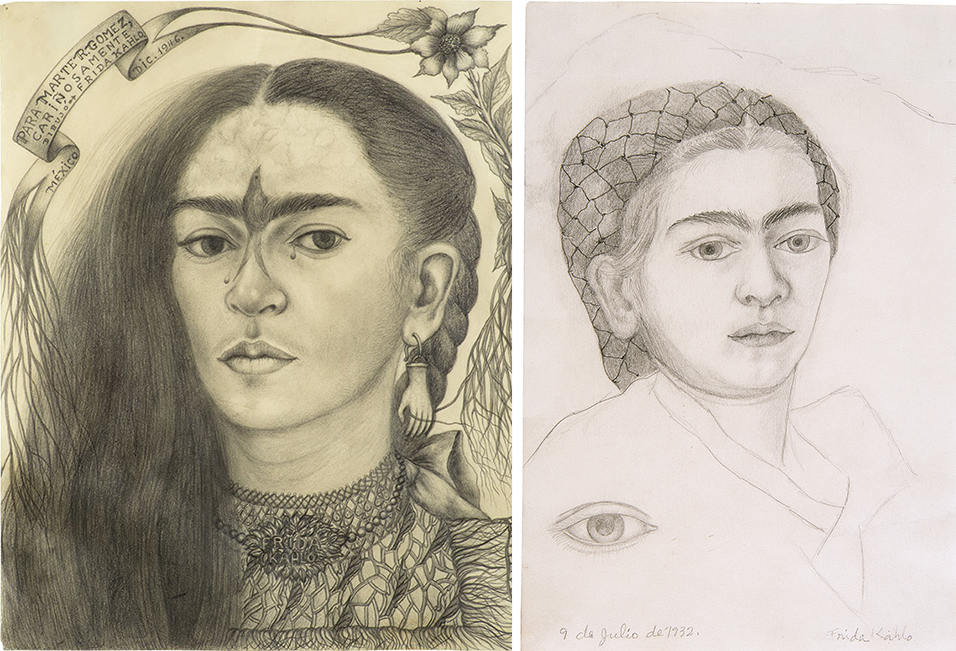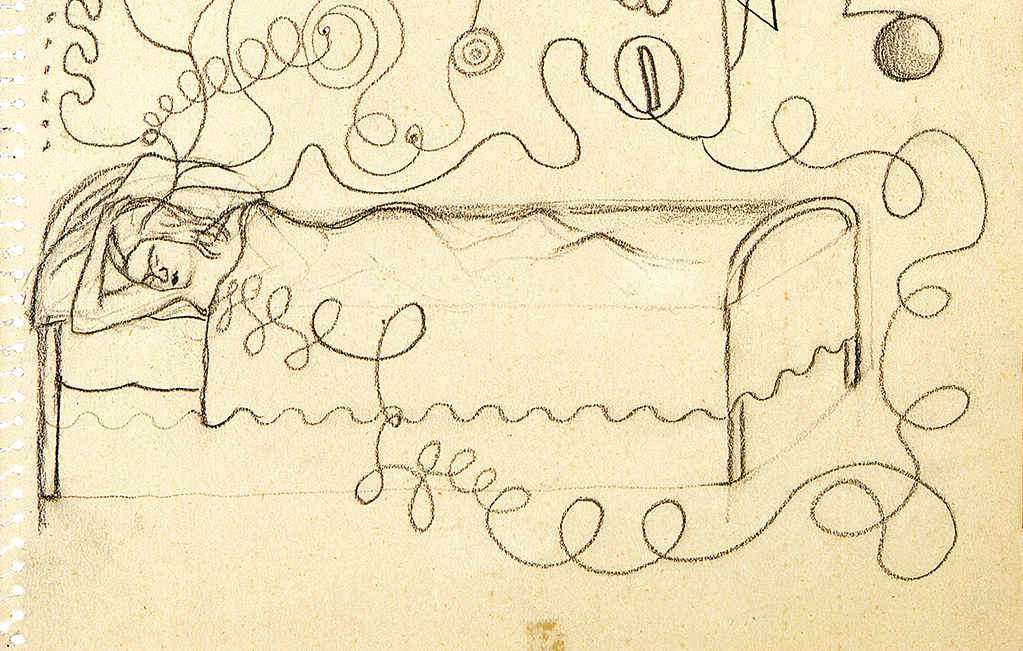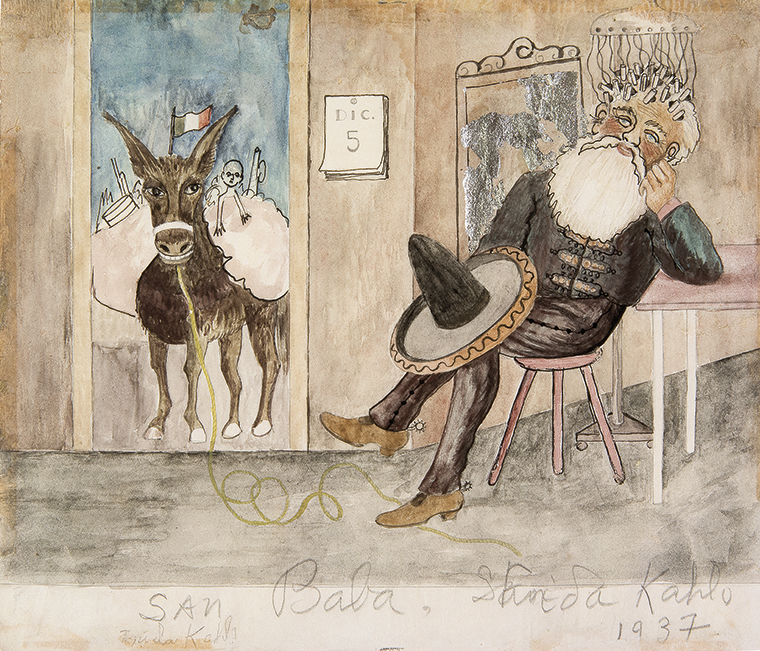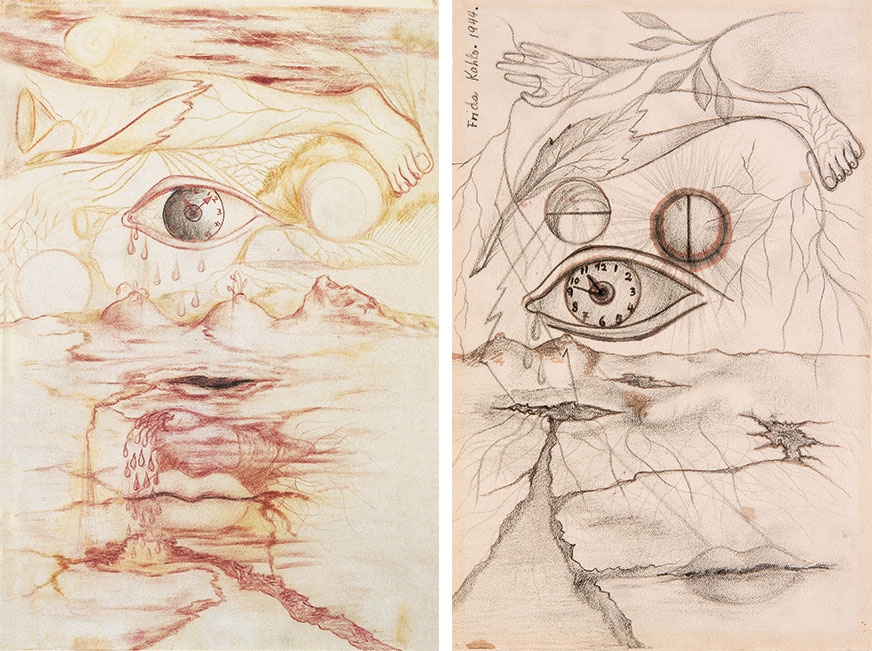Frida Kahlo: dreams, selfies and passionate encounters
She managed to carve out her own style and defied the conventions of her time. She suffered for love and was reborn at the age of 18 following a terrible accident. But despite her short life, she never stopped dreaming. Frida was born and died in the month of July. Her secret world comes to light in an ARTIKA edition that brings her most obscure works to light.
This will always be Frida Kahlo month
She was born on 6 July 1907 in Coyoacán, a small neighbourhood on the outskirts of Mexico City, where she grew up as a rebellious child with independent ideas. Her earliest health problems began at the age of seven and were further complicated after she was run over by a tram. She survived, however, and managed to turn the most painful events of her life into art, leading to drawings like The Accident (1926).

The accident (El accidente, 1926). Juan Coronel Collection. ®Photography: Rafael Doniz.
©2021 Banco de México Diego Rivera & Frida Kahlo Museums Trust. Av. 5 de Mayo No. 2, col. Center, alc. Cuauhtémoc, p.c. 06000, Mexico City
She had a miscarriage on 4 July 1932 and was admitted to Henry Ford Hospital, where she completed three of her most famous paintings: Self-Portrait on the Border between Mexico and the United States, Henry Ford Hospital and My Birth.
Frida died on 13 July 1954, seven days after her 47th birthday. Her last work is a still life of watermelons with a blue sky in the background. Written on one of the fruits is “Viva la vida. Frida Kahlo. Coyoacán 1954 – Mexico”.
The power of the image
Her father was a photographer, which may be why she got over her fear of the camera as a child. In the photos of her when she was young, she looks at the lens with the same intensity she displays in her best-known self-portraits. She knew how to capture the power of the image before she learned to paint.
Hers is a defiant gaze, a look that conveys strength and confidence. But it also reveals tenderness and pain, without hiding her vulnerability. This is why, in an age when everyone takes pictures of themselves using selfies, Frida’s face continues to move us.
Alongside her unjustly ignored contribution to the history of art, Frida was a pioneer in turning her image into an instantly recognisable symbol: the hairstyle, the tehuana costume and, of course, her characteristic eyebrows, are now part of popular culture.

Left: Self-portrait dedicated to Marte R. Gómez (Autorretrato dedicado a Marte R. Gómez, 1946). Ulla & Heiner Pietzsch Collection, Berlin. ©Photography: Jens Ziehe, Berlin.
Right: Self-portrait “9 July 1932” (Autorretrato “9 de Julio de 1932”, 1932). Juan Coronel Collection. ©Photography: Rafael Doniz.
©2021 Banco de México Diego Rivera & Frida Kahlo Museums Trust. Av. 5 de Mayo No. 2, col. Center, alc. Cuauhtémoc, p.c. 06000, Mexico City
A secret life
Frida lived a complex personal world hidden behind her image, where her innate vitality clashed with her insecurities. In the same way that she was able to camouflage references to her desires and fears in her paintings, her drawings give us a direct look into her more private life.
Her drawn self-portraits express her dreams and fantasies to a greater extent than her oil paintings. This is possible because she never intended to show any of her drawings to the public.
These works are rare. Some 130 drawings are believed to exist, scattered among several collectors and museums. All have been analysed for the first time for The Dreams of Friday Kahlo.
What she only expressed on paper
Thanks to this exclusive edition we’re able to discover how she began to translate her intimate visions into drawings like The Dream or Dreamlike Self-Portrait and particularly in Dreamlike Self-Portrait II, both from 1932.

Detail of The dream or dream-like portrait I (El sueño o Autorretrato onírico I, 1932). Museum Frida Kahlo, Mexico City. ©Photografy: Schalkwijk/Art Resource/Scala, Florence.
©2021 Banco de México Diego Rivera & Frida Kahlo Museums Trust. Av. 5 de Mayo No. 2, col. Centre, alc. Cuauhtémoc, p.c. 06000, Mexico City.
Her sentimental issues come to light in works like Ruin (1947), which symbolises the collapse of her relationship with Diego Rivera. She also dedicated sweet portraits to her friends and lovers. In these portraits she used humour and even mockery, like in San Baba (1937), an ironic watercolour dedicated to Leon Trotsky.

San Baba, 1937. Museo de Arte Moderno, México. © Foto: Rafael Doniz
© 2021 Banco de México Diego Rivera & Frida Kahlo Museums Trust. Av. 5 de Mayo No. 2, col. Centro, alc. Cuauhtémoc, c.p. 06000, Mexico City
Frida often drew, especially when she was confined to bed. This gave rise to works such as A Letter (1943), Fantasy I and Fantasy II (1944) and Appearances Deceive (1953). The artist lays bare her soul in these images in the same way as doctors laid bare her body.

Left: Fantasy I (Fantasía I, 1944). Museum Dolores Olmedo, Mexico City. ©Photography: Rafael Doniz.
Right: Fantasy II (Fantasía II, 1944). Particular Collection, Mexico City. ©Photography: Rafael Doniz.
©2021 Banco de México Diego Rivera & Frida Kahlo Museums Trust. Av. 5 de Mayo No. 2, col. Centre, alc. Cuauhtémoc, p.c. 06000, Mexico City.
This artistic legacy includes a particularly striking group of enigmatic sepia drawings, which she shared with one of her lovers, the painter José Bartolí. We can now look at these works and discover some of their hidden meanings.
Beyond interpretations, Frida clearly created these little jewels in the same way she decided to live her life: freely, imaginatively and with a groundbreaking spirit.
The artist who left us her dreams
- The Dreams of Frida Kahlo is an exclusive creation that reveals the intimacy of an icon of 20th-century art. Her drawings are the least well-known side of her artistic output.
- The book is an in-depth study that brings together, for the first time ever, a scattered legacy of portraits, fantasies and sketches secretly dedicated to friends and lovers.
- It is a limited edition of only 2998 copies. The work consists of a wooden case with the image of one of his paintings that reveals: the Art Book, with 34 original scale plates; the Study Book, with more than 100 drawings; and the Art Folder, with the reproduction of a large print.

